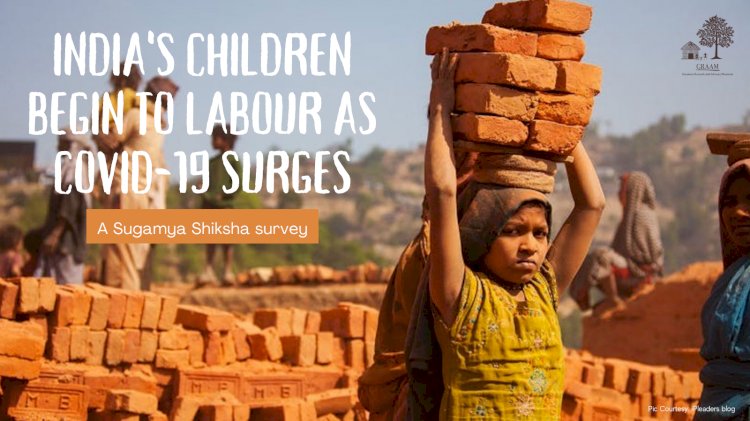India's children labour as COVID 19 surges: A Sugmya Shiksha survey

The year 2020-21 has been a year of unprecedented challenges. COVID-19 paused education of millions of children for an uncertain period. This has not only disturbed schooling and the learning process, impacting the lives of children in the longer term. Students being out of schools, their development is getting impaired with them engaging in undesirable activities.
To cope with the loss of schooling, GRAAM introduced Community Learning Centres under the Sugamya Shiksha programme. With five learning centres started across different locations in Mysuru, Sugamya Shiksha regularly engaged more than 250 students, involving them in a continued learning process. Through the process of setting up the community learning centres, the team of Sugamya Shiksha interacted with the villagers to collect information about the children from the communities. Apart from child marriages, many cases of child labour surfaced during our interaction with the children and the community.
With COVID-19 shutting schools last year, good monsoon gave a boost to agriculture and related activities in the rural area. Thus, there was a huge demand for agricultural labour, encouraging students to be involved in agricultural work. Some of the students who could not avail online education initiated by the government, spent time selling masks and vegetables. Few others got involved at construction sites and poultry farms.
If such a situation were to prevail for a longer period, it could potentially disinterest children from going back to school and continue learning. This could also mean an increase in child labour, reversing decades worth of work in bringing them out of situations of labour to schools. We share a few of our experiences here.
- Despite Mysuru being the capital city of culture and heritage, there are numerous instances of child labour still at play in the city. Many such cases have been witnessed in and around Sugamya Shiksha’s community learning centres. One such centre is in Beerihundi village of Mysuru Taluk, where many high school students without realising what to do and seeing no options for a future, have opted to take up jobs with the closure of schools. Akul and Ajay(names changed), studying in 9th standard, joined as construction workers to earn money for purchasing a mobile phone. They chose to work at a construction site for INR 400 per day with their parents’ consent, a tragedy in the making with the closure of schools.
- Several children are helping their parents manage their families in D. Salundi village. Many parents are taking their children along with them to work in fields, showing reduced interest in their children’s education. Locals inform that many of the children who were studying in 5th standard are engaged in grazing cows and collecting eggs in a poultry farm. Even though our learning centres are very near to this village, children continue to be engaged in daily wage work.
- Manoj, 5th standard, and Sooraj, 8th standard (names changed), both are the residents of D. Salundi village. They assist their parents earn for the family by working at a nearby construction site. Children who should have been climbing the steps of a potentially bright future are now climbing piles of crushed stones, sand and bricks.
- Udbur is one among the highly populated villages in Mysuru district. There are a lot of educated youth from this village who work in Mysuru city. Majority of the students belonging to this village are in government schools. It is pleasing to see such a huge enrolment of students in a government school. But, at the same time, it is tragic that several social evils are still present in this village. Child marriage and child labour are two of them being practiced even today. With COVID outbreak, these have only worsened with no checks in place and with no fear of being ostracized for practicing the same.
- Nearly eight 10th standard children were observed to be engaged in construction work. Nearly 10-15 children were identified working in poultry farms. Children earlier would work for money during their summer and Dasara holidays in bakeries. But with schools being closed for an extended period due to COVID, a lot many more more are now working at bakeries. It is unfortunate to learn that their parents have permitted children to work instead of encouraging them to continue with their studies.
When we study case studies like above, we come to a conclusion that children end up as child labours for social and financial reasons, due to natural calamities, legal conflicts, child trafficking, illiteracy, and skill gap. Parents who are facing problems like above are not aware of pervading laws and their applicability. Although a few are aware of such legalities, they are forced to send them to work in order to be able to lead a life. Although COVID has opened up new possibilities for children in the form of digitalised education, it has also accommodated a surge in cases of child labour on the flip side, deterring the efforts to secure the future generation of the country.
What's Your Reaction?





















